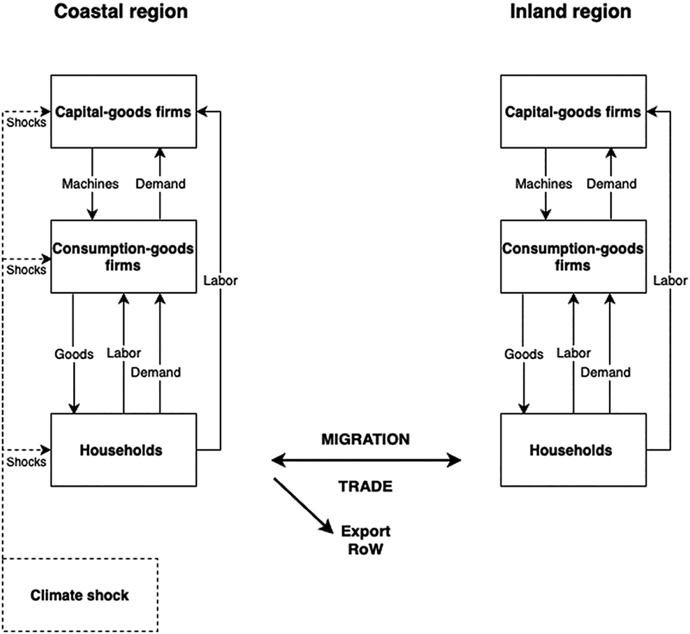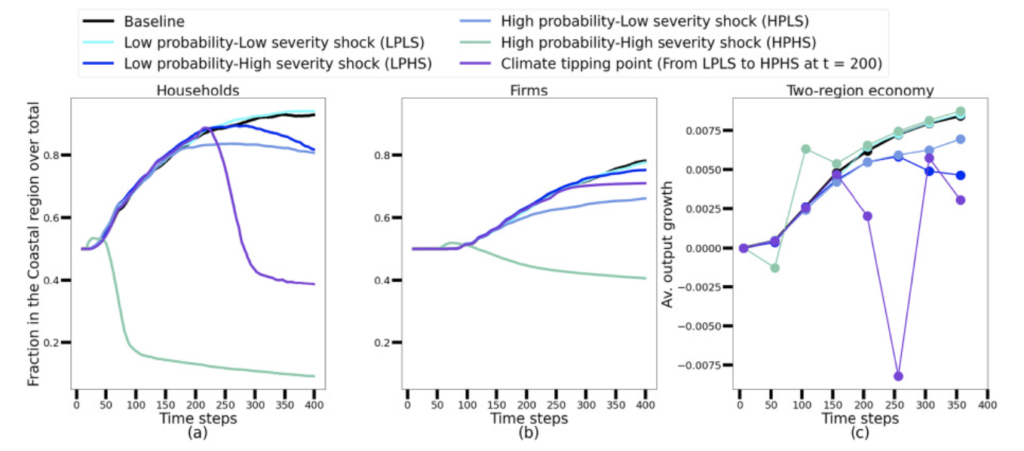Paper
- Coping with increasing tides: Evolving agglomeration dynamics and technological change under exacerbating hazards
- Ecological Economics, 2022
- Alessandro Taberna, Tatiana Filatova, Andrea Roventini, Francesco Lamperti
- https://doi.org/10.1016/j.ecolecon.2022.107588
Cities are the engine of the world economy: they provide jobs, cultural and educational amenities, and serve as incubators of innovations. By 2050 up to 70% of the world’s population is expected to live in cities, many of which, for a variety of historical reasons – such as access to natural amenities, resources, or strategic transportation routes (i.e. ports) – developed along rivers and coasts. However, a worsening climate makes their location more exposed to flooding and sea-level rise. Will the latter move clusters of economic activities and population away from climate-sensitive areas? Or slow down their growth? Besides the straightforward risks, are there any opportunities climate shocks offer to improve economic growth and development? And how?
To explore these research questions, we build the Climate-economy Agent-Based (CRAB) model, whose first theoretical version was published open access earlier this year in Ecological Economics.
This version of the CRAB model simulates evolutionary dynamics in two imaginary regions: Coastal and Inland. In contrast to the safe Inland region, the Coastal one has a competitive advantage in trade with the rest of the world. Yet, it also experiences flood hazards whose severity and probability can be varied. The regions are populated with heterogeneous households and firms belonging to two vertically-integrated sectors. In addition, households and firms are mobile, and they can migrate across the two regions as well as exchange goods and labor.

The first goal was to mimic a stylized situation where clusters of economic activities spontaneously emerge and grow in areas that offer spatial advantages (i.e. port -the Coastal region in our stylized world-). The second was to analyze the interplay between such phenomena and climate shocks of different severity and frequency (we tested different combinations of frequency and severity, summarized in Figure 2).
Our simulation results show that in the absence of floods, when the Coastal region holds natural spatial advantages, such as being a transportation hub, it will experience an inflow of economic activities from the Inland region. This agglomeration process is triggered by the additional resources that the region obtains through trade, which foster innovation, creating employment and business opportunities. Nonetheless, when climate shocks are introduced, their frequency and severity affect the final distribution of economic activities between climate-sensitive and safe regions as well as the economic growth of the whole economy. The most important takeaways are that when shocks are mild or infrequent, they negatively affect economic performance. If strong flood hazards hit frequently, the Coastal region before agglomeration forces trigger high levels of waterfront urbanization, firms and households can timely adapt and retreat in the safe inland region, thus averting the adverse impacts of climate shocks on the whole economy. Conversely, in the presence of climate tipping points where the frequency and magnitude of flood hazards abruptly intensify, we find that economic activities remain trapped in the hazard-prone region, generating lock-ins and leading to a harsh downturn of the overall economy.

Importantly, as in any simulation model, such results are based on many assumptions and represent a rather stylized world. However, they deliver important policy implications about the interplay between economic and climate forces. For instance, it shows that positive coastal retreat is possible when aligned with economic incentives of firms and households. Conversely, it counter-intuitively displays how early protection, while essential, tend to fuel agglomeration forces and endanger increasing sunk costs due to accelerating urbanization in climate-sensitive hotspots. Moreover, the model provides a general understanding of the importance of a comprehensive framework that includes both firms and households and how their interactions, as well as cumulative individual actions, shape regional climate-induced damage and resilience. We argue that these features are an essential starting point for any simulation model that investigates long-term climate adaptation strategies.
